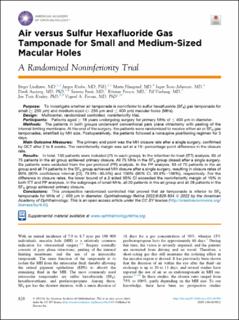| dc.description.abstract | Purpose: To investigate whether air tamponade is noninferior to sulfur hexafluoride (SF6) gas tamponade for small (≤ 250 μm) and medium-sized (> 250 μm and ≤ 400 μm) macular holes (MHs).
Design: Multicenter, randomized controlled, noninferiority trial.
Participants: Patients aged ≥ 18 years undergoing surgery for primary MHs of ≤ 400 μm in diameter.
Methods: The patients in both groups underwent conventional pars plana vitrectomy with peeling of the internal limiting membrane. At the end of the surgery, the patients were randomized to receive either air or SF6 gas tamponades, stratified by MH size. Postoperatively, the patients followed a nonsupine positioning regimen for 3 days.
Main Outcome Measures: The primary end point was the MH closure rate after a single surgery, confirmed by OCT after 2 to 8 weeks. The noninferiority margin was set at a 10–percentage-point difference in the closure rate.
Results: In total, 150 patients were included (75 in each group). In the intention-to-treat (ITT) analysis, 65 of 75 patients in the air group achieved primary closure. All 75 MHs in the SF6 group closed after a single surgery. Six patients were excluded from the per-protocol (PP) analysis. In the PP analysis, 63 of 70 patients in the air group and all 74 patients in the SF6 group achieved MH closure after a single surgery, resulting in closure rates of 90% (95% confidence interval [CI], 79.9%–95.5%) and 100% (95% CI, 93.9%–100%), respectively. For the difference in closure rates, the lower bound of a 2-sided 95% CI exceeded the noninferiority margin of 10% in both ITT and PP analyses. In the subgroups of small MHs, all 20 patients in the air group and all 28 patients in the SF6 group achieved primary closure.
Conclusions: This prospective randomized controlled trial proved that air tamponade is inferior to SF6 tamponade for MHs of ≤ 400 μm in diameter. | en_US |

